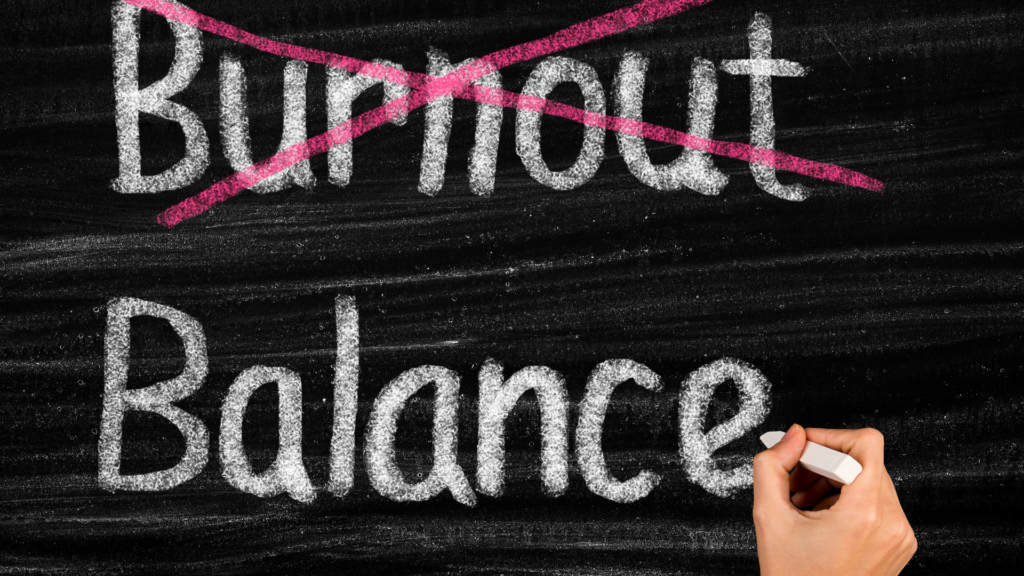
Balancing a demanding career with family life is no small feat. As a full-time trauma surgeon and mother of six, I’ve faced more than my fair share of challenges. But through it all, I’ve learned that burnout is real and can be dangerous when not dealt with. The pressure to excel at home and in the workplace can often lead to physical and mental exhaustion, affecting your health and happiness. Whether you have six children or one, the struggle to balance your family and career can put you at increased risk of burnout and its consequences. In this article, we’ll explore how to avoid burnout in the workplace so you can thrive without sacrificing your well-being.
Understanding Burnout
The word ‘burnout’ is thrown around a lot these days. But what exactly is burnout?
The World Health Organization now recognizes burnout as an occupational phenomenon, defining it as a syndrome resulting from chronic workplace stress that hasn’t been successfully managed. The constant exhaustion, the cynicism, the feeling of just going through the motions at work…it’s not a fun place to be. There’s nothing like general surgery residency to teach you job burnout firsthand. Being on call for more than 24 hours several times per week. And add pregnancy and children at home…I can confidently say I felt burned out to my bones!
Physical Symptoms of Burnout
Work burnout takes a serious toll on the body. Exhaustion and fatigue are common physical burnout symptoms. Sleep disturbances are also common, leaving you feeling tired and groggy all the time. Burnout research shows that the prevalence of physical illnesses, including musculoskeletal and cardiovascular diseases, increases with the severity of burnout.
Emotional and Mental Symptoms of Burnout
Burnout doesn’t just affect you physically – it wreaks havoc on your emotions, too, leading to severe mental and physical exhaustion. Emotional exhaustion is a hallmark of burnout, where you might feel like you have nothing left to give emotionally. You may experience irritability, anger, and mood swings. You may also snap at coworkers or loved ones for no real reason. Anxiety, depression, and a general sense of detachment or apathy can also set in, worsening the feelings of exhaustion. You may also find that you no longer enjoy things that used to excite you or bring you satisfaction in your work.
Causes and Risk Factors of Workplace Burnout
So, what causes burnout in the first place? While everyone’s situation is unique, some common factors can contribute to workplace stress and eventual burnout.
Heavy Workload and Long Hours
A consistently high workload and long work hours are a recipe for burnout. It eventually takes a toll when you’re constantly bombarded with an increasing workload with no end. I’ve been there – operating throughout the day and late into the night while also taking care of the continued flow of trauma patients coming through the emergency department. At first, you might feel like a superhero who can do it all. But over time, that prolonged stress catches up with you.
Lack of Control and Autonomy
A significant risk factor for burnout is feeling like you have no control over your work or schedule. When you’re at the mercy of unrealistic deadlines, unclear expectations, or micromanaging bosses, it’s easy to feel overwhelmed and powerless. Autonomy is crucial for job satisfaction and engagement. Without it, motivation quickly dwindles, and resentment builds.
Poor Work-Life Balance
When work starts to consume your life, burnout is often not far behind. Poor work-life balance means you never have time to recharge your batteries or pursue interests other than work, significantly impacting your personal life. You might feel guilty for taking time off or constantly checking emails during family time. That constant “on” mode is not sustainable in the long term.
Workplace Discrimination

A rarely discussed risk factor for burnout is workplace discrimination. If you’re an underrepresented minority in your field, you may sometimes be the “only one” in your workplace. Depending on the workplace culture, you may experience racial and ethnic slurs, lack of advancement, and even unfair treatment. Studies have shown that those who reported frequent discrimination at work were more likely to experience burnout compared with those who experienced infrequent discrimination.
I experienced an exacerbation of my burnout due to various types of workplace discrimination, including anti-Black racism, sexism, pregnancy discrimination, and Islamophobia. And while I could read about and learn time management and balance, I had minimal resources to deal with the stress of workplace discrimination. Increased work demands, lack of control, poor work-life balance, and workplace discrimination can create a perfect storm for burnout. And once you’re in the thick of it, it can be hard to see a way out.
Impact of Burnout on Employee Health
Burnout is so much more than just a bad day at work. When left unchecked, it can have severe consequences for your physical and mental health.
Increased Risk of Mental Health Disorders

The chronic stress of burnout puts you at a higher risk for developing mental health issues such as depression, anxiety, and even substance abuse. It’s a vicious cycle – the more burned out you feel, the more your mental health suffers. And as your mental health declines, it becomes even more challenging to cope with the stresses of work.
In the healthcare field, for example, we’ve seen physicians turn to alcohol or drugs to cope with stress. And because healthcare professionals are less likely to seek treatment for mental health disorders, we’ve seen an increase in physician suicide rates. Male physicians die by suicide 2-3 times that of the general population, while the incidence is 5-6 times the general population for female physicians.
Substance Abuse and Addiction
Substance abuse is a common coping mechanism for managing the stress and emotional pain of burnout. What starts as a few extra drinks after work can quickly spiral into addiction. Substance abuse only compounds the problems of burnout and makes it even more challenging to recover. Suppose you find yourself relying on alcohol, drugs, or other unhealthy coping mechanisms to get through the workday. In that case, seeking help is essential before things get worse.
Consequences of Burnout for Organizations
Burnout isn’t just a personal problem – it’s an organizational one, too. When employees experience burnout, it can significantly impact the company.
Decreased Productivity and Performance
When you’re burned out, your work suffers. It’s hard to be productive or perform at your best when physically and mentally exhausted. You may start missing deadlines, making more mistakes, or generally not caring about the quality of your work. Over time, this can lead to a significant drop in individual and team performance. I’ve seen it happen in medicine – a once high-performing physician slowly starts to disengage and drop the ball. What makes this worse in healthcare is that poor quality work may have life-threatening consequences for your patients. And the guilt of dealing with poor patient outcomes only worsens the symptoms of burnout. It’s a lose-lose situation for everyone involved.
Increased Absenteeism and Turnover
Burnout often leads to increased absenteeism as employees take more sick days to cope with the stress. In extreme cases, it can even lead to long-term disability leave. And when burnout becomes too much to bear, many employees will quit. High turnover rates are a common consequence of a burned-out workforce and a sign that the workplace culture may be the culprit. This revolving door of employees is costly for organizations regarding time, money, and institutional knowledge.
Key Takeaway:
Burnout is more than stress; it’s a severe issue sparked by chronic workplace pressure that manifests as exhaustion, cynicism, and reduced efficiency. Recognizing its physical and emotional signs early on can help stop the cycle before it worsens.
Strategies for Preventing and Managing Burnout
Now that we’ve established the serious consequences of burnout, let’s turn to strategies for avoiding it altogether. Burnout is not only a personal issue but a problem that affects millions of workers globally, and companies must step up and take an active role in preventing it.
The Role of Leadership in Addressing Burnout
Leaders play a crucial role in addressing burnout within their teams. They must be trained to recognize the signs of burnout and take proactive steps to provide support and resources. Understanding and managing the human stress response is essential for leaders to prevent burnout among employees by recognizing early signs and employing relaxation techniques.
Recognizing Signs of Burnout in Employees
Leaders can recognize burnout by staying attuned to warning signs like decreased productivity, increased absenteeism, and changes in employee behavior or attitude. By catching burnout early, leaders can intervene before it escalates. It can be challenging to spot burnout, especially in a remote or hybrid work environment. But it’s a skill managers need to develop to keep their teams healthy and engaged.
Promoting Work-Life Balance

One key strategy is promoting work-life balance. This means setting clear boundaries between work and personal time and encouraging employees to disconnect and recharge when they’re off the clock. An essential aspect of workplace culture leaders should consider to prevent burnout is flexibility. How flexible is your work schedule, and what can you do to accommodate employees who need more flexibility? Let’s face it: the current workplace culture continues to be rigid. It limits the ability of employees, especially women, to overcome burnout.
Creating a Burnout-Resistant Workplace Culture
Creating a burnout-resistant workplace culture requires a holistic approach, prioritizing employee well-being at every level of the organization. Incorporating tools like the parental burnout inventory can offer valuable insights into the specific challenges faced by parents, aiding in the development of targeted support strategies.
Key Takeaway:
Beat burnout by recognizing the signs in employees, promoting work-life balance by providing flexibility, and fostering a burnout-resistant workplace culture. Leaders should spot burnout signs early, support struggling team members, and mitigate workplace risk factors by promoting a responsive and flexible workplace culture.
What if your workplace culture is burnout-prone?
Many workplaces, especially in high-pressure industries like healthcare, have difficulty preventing burnout. Long hours, high-pressure environments, and a lack of support systems contribute to this pervasive issue, especially when the culture prioritizes patient care over healthcare workers’ well-being.
So, how do you avoid burnout in these environments?
Strategies to Avoid Burnout When Your Workplace Is Burnout-prone
Achieving balance in high-pressure and competitive environments can be difficult but possible. Juggling a demanding career and family responsibilities can be exhausting. Still, with the right strategies, you can avoid experiencing the severe consequences of burnout. Here are some strategies that have helped me manage my role as a full-time trauma surgeon and a mother of six. These tips can help you reduce stress, increase productivity, and maintain a healthier, more balanced life.
1. Self-Care & Time Management
Prioritize Self-Care Activities:
Relaxation: Incorporate downtime into your schedule to recharge and avoid feeling overwhelmed. Relaxation can take many forms, from a quiet evening with an excellent book to practicing mindfulness techniques. Ensuring you have moments of rest is crucial for maintaining energy levels and preventing stress from accumulating. Downtime allows your mind and body to recover, reducing the risk of burnout. I achieve this by scheduling off days from all activities, including home and work.
Hobbies & Interests Outside of Work: Another critical strategy is cultivating hobbies and interests outside of work. Engaging in activities that bring joy, relaxation, and a sense of accomplishment can help counteract the adverse effects of burnout. For exhausted parents, who may often feel overwhelmed, finding time for hobbies can be particularly beneficial, offering a much-needed respite and a way to recharge. Whether painting, hiking, or learning a new language, having a fulfilling life outside work is crucial for maintaining balance and preventing burnout.
Effective Stress Management Techniques: These can include mindfulness meditation, deep breathing exercises, and regular physical activity. By incorporating these techniques into their daily routines, employees can better cope with work-related pressures and maintain their health. It can be challenging to find time for self-care, especially when work is hectic. But it’s an investment that pays off personally and professionally in the long run.
Effective Time Management Techniques:
Time Blocking: Allocate specific time slots for tasks to enhance focus and productivity. By breaking your day into manageable chunks, you can concentrate on one task at a time without feeling overwhelmed. This method helps you stay organized and ensures you complete essential tasks efficiently. Time blocking also allows for scheduled breaks, which is crucial for preventing burnout.
Prioritizing Tasks: To manage your workload effectively, identify and tackle high-priority tasks first. Make a list of tasks and rank them by importance and urgency. Focusing on what truly matters can reduce the stress of an overwhelming to-do list.
2. Setting Boundaries
Saying No: Learn to decline additional responsibilities that could overwhelm you. It’s essential to recognize your limits and avoid overcommitting yourself. Saying no when necessary is crucial for protecting your time and energy. It’s not about shirking responsibilities but about ensuring you can perform your existing tasks effectively and without undue stress.
Say it with me: “No! It’s a full sentence.”
Delegating Tasks: Assign tasks to others when possible to manage your workload better. Delegation is critical to maintaining a balanced workload, especially in professional and personal settings. Trusting others with responsibilities lightens your load and empowers your team or family members. Effective delegation can improve efficiency and prevent burnout by avoiding the burden of doing everything yourself.
3. Seeking Support
Building a Support Network:
Family and Friends: Lean on your loved ones for emotional and practical support. A strong support network can provide encouragement, advice, and a sense of belonging. Sharing your challenges and successes with those who care about you can alleviate stress. Family and friends can offer different perspectives and help you navigate difficult situations more easily.
Colleagues: Foster supportive relationships with your coworkers for mutual assistance. Building a network of colleagues you can rely on creates a collaborative and supportive work environment. Mutual support among coworkers can improve morale and reduce the feeling of isolation. Knowing you have allies at work can make a significant difference in managing stress and preventing burnout.
Utilizing Professional Resources:
Counselors: Seek professional help to navigate stress and emotional challenges. A counselor can provide valuable tools and techniques for managing stress and improving mental health. Professional support can help you develop coping strategies tailored to your specific situation. Regular sessions with a counselor provide a safe space to explore and address underlying issues contributing to burnout.
Coaches: Career coaches can provide guidance and strategies for balancing work and life. A coach can help you set realistic goals, develop a career plan, and navigate professional challenges. They can offer insights and advice based on their expertise and experience. Working with a coach can enhance your personal and professional growth, helping you achieve a more balanced life. However, not all coaching is created equal. Many coaching programs do not address some risk factors contributing to workplace burnout, especially inflexible work schedules, discrimination, and hostile workplaces. Many employees are left to deal with these independently. They are forced to either push back and risk retaliation or remain silent.
4. Self-Advocacy

Self-advocacy is the most important strategy for avoiding burnout. It is an essential skill for maintaining a healthy work-life balance, especially in demanding careers and especially as a woman or any other underrepresented minority. It’s the one skill that helps you challenge the harmful workplace cultures that make balance impossible. By effectively communicating your needs and advocating for yourself, you can manage stress, avoid burnout, and create a more supportive work environment. And that’s why self-advocacy is the cornerstone of our coaching program at Defiance Academy.
How Self-Advocacy Changed My Life
I had all my children during my residency. My first pregnancy occurred just two months into my first year of training. At the time, our program did not have a maternity leave policy. The institution’s culture was that women waited until they were graduating to have children, or they dropped out if they were early in their training. I was essentially shown the door since being pregnant as an intern was NOT part of the program’s culture.
After advocating for a maternity leave policy to be instituted, I was able to continue my training after I delivered my daughter. And because I continued to advocate for other changes I needed, I was able to continue to grow my family as I completed my training. I also completed fellowship training in critical care after residency and had my youngest son, baby #6, during that year.
It was also through self-advocacy that I was able to deal with and overcome the workplace discrimination that’s been a significant contributor to my burnout experience.
Advocating for yourself can create a more manageable and supportive work environment. Speaking up about workload and stress, effectively communicating with supervisors and colleagues, and proposing practical solutions are vital steps in this process. Remember, self-advocacy is not just about addressing immediate concerns; it’s about building a sustainable and fulfilling career.
Key Takeaway:
Even in a burnout-prone workplace, you can avoid burnout by prioritizing self-care and time management, setting boundaries, seeking support, and advocating for yourself. You’re not hopeless or powerless, despite what these workplace cultures may have you believe.
Conclusion
Overcoming the challenges of burnout is a continuous journey. Still, with the right strategies, achieving a fulfilling balance between work and life is possible. Remember, prioritizing your well-being is essential not just for you but for those who depend on you. Take action today, speak up for your needs, and embrace the power of self-advocacy. You have the strength to overcome any obstacle and create a life that aligns with your personal and professional goals.
Remember, you’re not a machine—you’re a human being with needs and limits. It’s okay to say no, take breaks, and ask for help. Your productivity does not measure your worth.
So take a deep breath, be kind to yourself, and know you can create a more sustainable, fulfilling life. You’ve got this.
Join the Conversation
I invite you to share your experiences and strategies for avoiding burnout in the comments below. We can support and inspire each other on this journey towards a balanced and fulfilling life.

